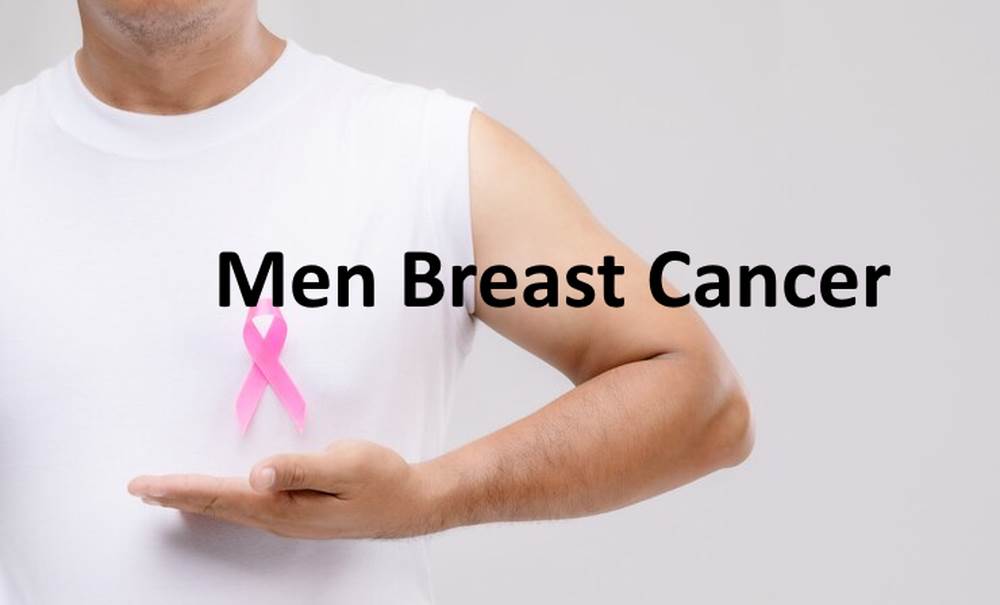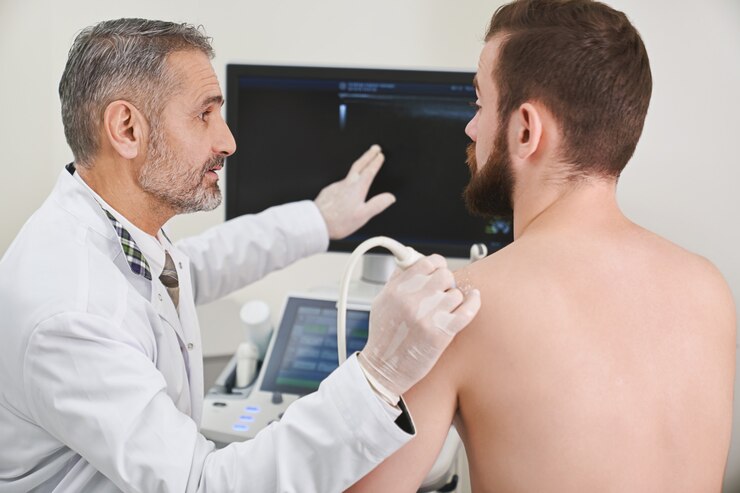Although breast cancer is far more prevalent in women, it can occur in men as well. Breast cancer in men, however, is less frequent, making up around 1% of all breast cancer diagnoses. In the U.S., there are around 2,650 cases each year and approximately 1 in 830 men will get It in their lifetime.
Key Takeaways
- Male breast cancer is rare, accounting for less than 1% of all cases.
- The most common type of male breast cancer is ductal carcinoma, which begins in the breast ducts.
- Risk factors for male breast cancer include genetic factors, age, hormonal imbalances, and lifestyle choices.
- Early detection through awareness of symptoms and diagnostic tests is crucial for effective treatment.
- Treatment options for male breast cancer are similar to those for female breast cancer, including surgery, chemotherapy, radiation, and hormone therapy.
Understanding Male Breast Cancer
What is Male Breast Cancer?
It develops in the breast tissue of men and people assigned male at birth (AMAB). Your chest contains breast tissue where cancer cells can grow. Without treatment, cancer can spread throughout your body. Treatment includes surgery, chemotherapy, radiation, and hormone therapy. The outlook depends on your cancer stage.
How Common is Male Breast Cancer?
Breast cancer in men is rare, but it can grow and spread like any other cancer if left untreated. Since men are usually less familiar with its signs and symptoms—and because many are unaware that they can be affected by it—their breast cancer is often not diagnosed until it’s in a later, more advanced stage. Greater awareness of male breast cancer is needed.
Types of Male Breast Cancer
There are several types of male breast cancer, including:
- Ductal carcinoma in situ (DCIS)
- Invasive ductal carcinoma (IDC)
- Invasive lobular carcinoma (ILC)
- Paget’s disease of the nipple
- Inflammatory breast cancer
Each type has unique characteristics and treatment options. It’s crucial to identify the type to determine the most effective treatment plan.
Risk Factors for Male Breast Cancer
Genetic factors play a significant role in the risk of male breast cancer. A family history of breast cancer, particularly among female relatives, can increase the likelihood of developing the disease. Additionally, mutations in the BRCA2 gene are known to elevate the risk.
Age and Hormonal Factors
Male breast cancer typically develops in men between the ages of 60 and 70. Hormonal imbalances, such as high estrogen levels and low levels of male hormones, are also contributing factors. Conditions like cirrhosis or Klinefelter syndrome, which are associated with hyperestrogenism, further increase the risk.
Lifestyle and Environmental Factors
Several lifestyle and environmental factors can elevate the risk. These include:
- Previous radiation therapy in the chest area
- Lack of exercise
- Obesity
- Heavy alcohol intake
- Estrogen treatment, often used to treat prostate cancer
- Gynecomastia (enlarged breasts)
Understanding these risk factors is crucial for early detection and prevention of male breast cancer.
Symptoms and Diagnosis

Common Symptoms
Physical changes in your breast tissue are often the first noticeable signs of breast cancer. The most common warning sign of breast cancer in men is a painless lump or thickening in the breast or chest area. Other symptoms may include:
- Changes to the skin covering your breast, such as dimpling, puckering, redness, or scaling.
- Nipple retraction or discharge.
- Swelling in the breast.
Diagnostic Tests
Your healthcare provider will ask about your symptoms, family history of breast cancer, and other risk factors. They’ll perform various tests or procedures to make a diagnosis, including:
- Mammogram: An X-ray of the breast to look for abnormalities.
- Ultrasound: Uses sound waves to create images of the breast tissue.
- Magnetic Resonance Imaging (MRI): Provides detailed images of the breast.
- Biopsy: A small piece of breast tissue is removed, usually with a needle, and analyzed by a pathologist to check for the presence of cancer cells.
Importance of Early Detection
Early detection of male breast cancer significantly improves the chances of successful treatment. Men are not routinely screened for breast cancer, so any changes to your breasts should be checked by a doctor. Prompt medical attention can lead to early diagnosis and better outcomes.
Early detection and diagnosis are crucial for improving survival rates and treatment effectiveness in male breast cancer.
Treatment Options for Male Breast Cancer

Surgical Treatments
The main treatment for male breast cancer is surgery. The most common surgery is a modified radical mastectomy, which involves removing the breast, many of the lymph nodes under the arm, the lining over the chest muscles, and sometimes part of the chest wall muscles. Other surgical options include lumpectomy, which may be performed with SAVI SCOUT® technology, and breast reconstruction, either immediately or delayed after surgery.
Chemotherapy and Radiation
Male Breast Cancer Treatment: Options Similar to Women, Chemotherapy and radiation therapy are common treatments for both male and female breast cancer. These therapies target and destroy cancer cells: chemo uses drugs, while radiation uses high-energy rays.
Hormone and Targeted Therapies
Hormone therapy for male breast cancer often involves the medicine tamoxifen. Other hormone therapy medicines might be an option if you can’t take tamoxifen. Targeted therapies focus on specific characteristics of cancer cells, such as a protein that allows the cancer cells to grow rapidly or abnormally. These therapies can be effective in treating certain types of male breast cancer.
Early detection and a personalized treatment plan are crucial for the best outcomes in male breast cancer.
Living with Male Breast Cancer
Emotional and Psychological Support
Living with male breast cancer can be emotionally challenging. Connecting with others who have similar experiences can provide significant support. Many find solace in support groups, both in-person and online, where they can share their journey and receive encouragement. It’s essential to address mental health needs, and seeking professional counseling can be beneficial.
Follow-Up Care and Monitoring
After treatment, regular follow-up care is crucial. This includes scheduled visits with your healthcare provider to monitor for any signs of recurrence. The 5-year relative survival rate for men with breast cancer is 84%, highlighting the importance of ongoing monitoring. Follow-up care may involve physical exams, imaging tests, and blood work to ensure the cancer has not returned or spread.
Survivorship and Quality of Life
Survivorship involves managing the long-term effects of cancer and its treatment. Many men experience changes in their physical appearance and may need to adapt to new routines. Maintaining a healthy lifestyle, including a balanced diet and regular exercise, can improve overall well-being. It’s also important to stay informed about potential late effects of treatment and to communicate any concerns with your healthcare team.
Living with male breast cancer requires a comprehensive approach that includes emotional support, diligent follow-up care, and a focus on quality of life. By staying proactive and connected, men can navigate their journey with resilience and hope.
Preventive Measures and Screening
Who Should Get Screened?
Screening for male breast cancer is crucial, especially for those with a family history of the disease or genetic mutations like BRCA1 or BRCA2. Screening saves lives by detecting cancer early when it is most treatable. Men with these risk factors should discuss regular screenings with their healthcare provider.
Screening Methods
Several methods are available for screening male breast cancer, including:
- Mammograms: X-ray images of the breast to detect abnormalities.
- Ultrasound: Uses sound waves to create images of breast tissue.
- MRI: Provides detailed images using magnetic fields and radio waves.
Preventive Lifestyle Changes
While male breast cancer isn’t entirely preventable, certain lifestyle changes can help lower the risk. These include:
- Maintaining a healthy weight
- Regular physical activity
- Limiting alcohol consumption
- Avoiding tobacco use
Adopting these lifestyle changes not only reduces the risk of breast cancer but can also help prevent Alzheimer disease and other chronic conditions.
Conclusion
While breast cancer is predominantly associated with women, it is crucial to recognize that men can also be affected by this disease. Although rare, male breast cancer accounts for about 1% of all breast cancer cases, with approximately 2,650 new diagnoses in the U.S. each year. Men, like women, have breast tissue that can develop cancer, most commonly in the form of ductal carcinoma.
Risk factors for male breast cancer are similar to those for women and include age, genetic mutations, and family history. Early detection and treatment are vital for improving outcomes, and men at higher risk should consult their healthcare providers about appropriate screening measures.
Understanding that breast cancer does not discriminate by gender can lead to better awareness, early diagnosis, and more effective treatment for all affected individuals.
Frequently Asked Questions
What is male breast cancer in men?
Although breast cancer is far more prevalent in women, it can occur in men as well. Breast cancer in men, however, is less frequent, making up around 1% of all breast cancer diagnoses. In the U.S., there are around 2,650 cases each year and approximately 1 in 830 men will get breast cancer in their lifetime.
What is male breast cancer?
Male breast cancer is when there is abnormal cell growth in the breast cells of men. Though it is rare, men can get breast cancer. Just like women, men have breast tissue that can develop cancer. Most breast cancer in men is ductal carcinoma, which means the cancer cells begin growing in the (milk) ducts of the breast, but can also begin in the glands (lobular cancer), even though these breast parts are not functional in men.
What types affect men?
Several types of breast cancer can affect men, including * Ductal carcinoma. The most common type of breast cancer in men, ductal carcinoma develops in the breast ducts. * Lobular carcinoma. This type of cancer develops in the lobules. Because men typically have few, if any, lobules, this type of breast cancer is rare, making up only around 1% of male breast cancers.
How common is male breast cancer?
Breast cancer in men is rare — less than 1 percent of all breast cancer occurs in men. About 2,350 new cases of invasive breast cancer were diagnosed in men in the U.S. in 2015. Breast cancer is about 100 times more common in women. About 440 men in the U.S. died from breast cancer in 2015.
Should men at higher risk get screening mammograms?
Breast cancer is rare in men and according to the National Cancer Institute, “screening is unlikely to be beneficial.” Men who are at higher risk, such as those who have BRCA mutations or a family history of breast and/or ovarian cancer should talk to their doctor about screening mammograms.
How is breast cancer in men treated?
As with female breast cancer, standard treatments for male breast cancer include surgery, chemotherapy, radiation therapy, hormone therapy, and targeted therapy. The choice of treatment varies based on the stage of cancer, the tumor’s hormone receptor and HER2 status, and other factors.






